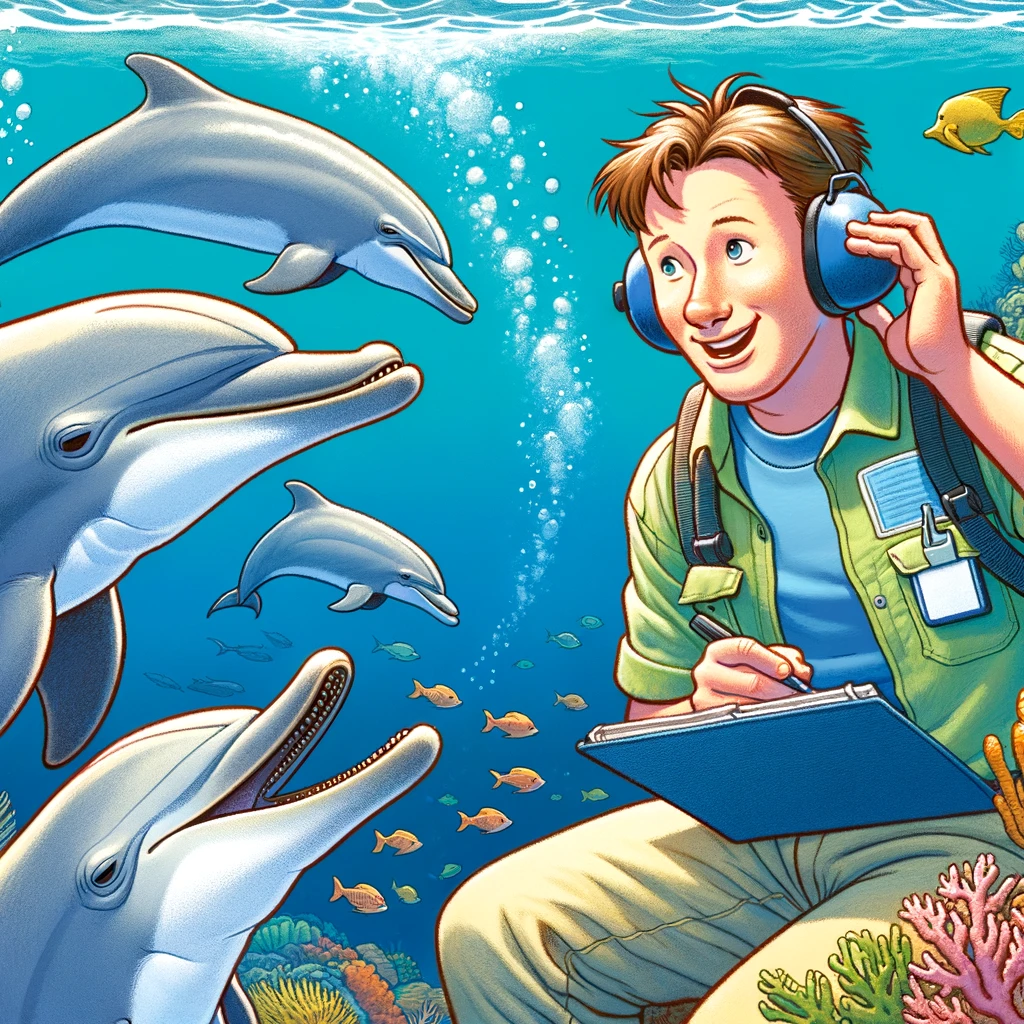Are you tired of feeling like a fish out of water when trying to communicate with your flippered friends? Do you dream of having deep, meaningful conversations with dolphins that go beyond just “eee eee eee” and “click click click”? Well, have no fear, my aspiring marine biologists! With these handy dolphin language lessons, you’ll be chatting up a storm with your cetacean pals in no time!
Why Learning Dolphin is Essential for Any Self-Respecting Marine Biologist
Before we dive into the nitty-gritty of dolphin language, let’s take a moment to appreciate why this skill is so crucial for any marine biologist worth their salt.
- Impress your colleagues: Imagine the look on your fellow researchers’ faces when you casually strike up a conversation with a passing pod of dolphins. They’ll be green with envy!
- Decipher important dolphin gossip: Who knows what juicy secrets you might uncover when you can understand the latest dolphin chatter? Maybe you’ll learn about the hottest new algae patch or the cutest bottlenose bachelor in town.
- Avoid awkward interspecies misunderstandings: There’s nothing worse than accidentally offending a dolphin with a poorly timed whistle. Learning their language will help you navigate the complex world of dolphin social etiquette.
Plus, let’s be real – it’s just plain cool to be able to say you can speak dolphin. It’s like being the Dr. Dolittle of the ocean!
The Basics of Dolphin Communication: Whistles, Clicks, and Body Language
Alright, let’s get down to business. Dolphin communication is a fascinating and complex topic, but we’ll break it down into bite-sized, fish-flavored morsels for you.
First up, we have whistles. Dolphins use whistles to communicate with each other over long distances, kind of like how you might yell across a crowded room to get your friend’s attention. Each dolphin has its own unique whistle, called a “signature whistle,” which is like their personal name tag.
Next, we have clicks. Dolphins use clicks for echolocation, which is how they navigate and find food in the murky depths of the ocean. It’s like a built-in sonar system, but way cooler because it’s attached to a dolphin.
Finally, we can’t forget about body language. Dolphins are master non-verbal communicators, using everything from tail slaps to head butts to get their point across. It’s like a game of charades, but with more fish and fewer bad acting skills.
Common Dolphin Phrases Every Marine Biologist Should Know
Now that you’ve got a handle on the basics of dolphin communication, it’s time to learn some key phrases that will help you blend in with the pod.
- “Eee eee click click”: This is dolphin for “Hey, how’s it going?” It’s a casual greeting that you can use to break the ice with any dolphin you meet.
- “Click whistle click”: This means “Check out that sexy dolphin over there!” Use this phrase to gossip with your dolphin buddies about the hottest fins in the sea.
- “Whistle whistle eee”: This translates to “Let’s go hunt some fish!” It’s the dolphin equivalent of “Let’s grab some pizza!” – a rallying cry for a tasty meal and some quality bonding time.
- “Click click whistle eee”: This means “Watch out, there’s a shark!” Dolphins have a complex system of warning each other about potential predators, so it’s important to know how to sound the alarm.
- “Eee click whistle whistle”: This is dolphin for “I love you.” Awww, how sweet! Use this phrase sparingly, unless you want to find yourself in a complicated interspecies romance.
Of course, these are just a few examples – there are countless other dolphin phrases to learn, from “Pass the seaweed, please” to “I think I swallowed a plastic bag, send help!”
Practicing Your Dolphin Language Skills: Tips and Tricks
Learning a new language is never easy, and dolphin is no exception. But with a little practice and patience, you’ll be fluent in no time! Here are some tips to help you hone your dolphin language skills:
- Start with the basics: Before you try to have a full-blown conversation with a dolphin, make sure you’ve mastered the fundamental whistles and clicks. You don’t want to accidentally say “I’m a tasty shark snack” instead of “I come in peace!”
- Find a dolphin language buddy: Learning is always more fun with a friend! Find a fellow marine biologist who shares your passion for dolphin communication and practice together. You can take turns playing the role of the dolphin and the confused human researcher.
- Immerse yourself in dolphin culture: To truly master dolphin language, you need to understand their way of life. Spend time observing dolphins in their natural habitat, studying their social hierarchies and hunting habits. The more you know about dolphin culture, the easier it will be to communicate with them.
- Don’t be afraid to make mistakes: No one becomes a dolphin language expert overnight. You’re bound to make some embarrassing faux pas along the way, like accidentally insulting a dolphin’s mother or mistaking a mating call for a dinner invitation. Just keep swimming and learn from your mistakes!
The Importance of Context in Dolphin Communication
One of the trickiest things about dolphin language is that context is everything. The same whistle or click can mean completely different things depending on the situation and the dolphin’s body language.
For example, a short, sharp whistle might mean “Look out, danger!” if a dolphin is frantically swimming away from a predator. But the same whistle could mean “Hey, let’s play!” if a dolphin is eagerly bouncing a seashell on its nose.
As a marine biologist, it’s important to pay attention to the entire context of a dolphin’s communication, not just the individual sounds. Watch their body language, notice their environment, and try to put yourself in their flippers. With practice, you’ll start to pick up on the subtle nuances of dolphin language and become a true master of cetacean communication.
Decoding Dolphin Slang: How to Sound Like a Local
Just like humans, dolphins have their own unique slang and regional dialects. If you want to sound like a true dolphin insider, you’ll need to learn some of the hippest and most happening dolphin lingo.
Here are a few examples of dolphin slang to get you started:
- “Flipper” – A term of endearment for a close dolphin friend, similar to “bro” or “dude” in human slang.
- “Blowhole” – A dolphin’s version of “mind blown,” used to express amazement or surprise.
- “Finsta” – A fake Instagram account that dolphins use to post embarrassing photos of themselves without their pod knowing.
- “Krill” – A slang term for money, similar to “dough” or “cheddar” in human slang.
- “Surf and turf” – A dolphin’s favorite meal, consisting of a delicious combination of fish and seaweed.
Of course, dolphin slang is constantly evolving, so it’s important to keep your ear to the seashell and stay up-to-date on the latest lingo. You don’t want to be the uncool marine biologist who’s still using outdated dolphin slang from the 90s!
Dolphin Pickup Lines: How to Woo Your Cetacean Crush
Alright, let’s be real – we all know the real reason you want to learn dolphin language is to impress that cute bottlenose you’ve been eyeing from across the coral reef. Don’t worry, we’ve got you covered with some smooth dolphin pickup lines that are guaranteed to make a splash.
- “Are you a dolphin trainer? Because you’ve got me jumping through hoops!”
- “I must be echolocating, because I’ve found the dolphin of my dreams.”
- “Do you believe in love at first click, or should I swim by again?”
- “Is your name Google? Because you’ve got everything I’m searching for.”
- “Are you a deep-sea diver? Because I think you’re my treasure.”
Use these pickup lines with caution – you don’t want to come on too strong and scare away your dolphin crush. And remember, consent is important in any language, so make sure you’re respecting your dolphin love interest’s boundaries and reading their body language carefully.
The Future of Dolphin-Human Communication
As our understanding of dolphin language grows, the possibilities for dolphin-human communication are endless. Who knows what the future may hold?
Perhaps one day, we’ll have dolphin translators that allow us to have full-blown conversations with our flippered friends. Or maybe we’ll discover that dolphins have their own complex system of writing, hidden in the patterns of their whistles and clicks.
The one thing we do know is that the more we learn about dolphin language, the more we realize how much we still have to learn. As marine biologists, it’s our job to keep pushing the boundaries of what’s possible and to never stop exploring the fascinating world of dolphin communication.
So, my fellow aspiring marine biologists, keep practicing your whistles and clicks, keep studying those dolphin social hierarchies, and most importantly, keep dreaming big. Who knows – maybe one day, you’ll be the one to crack the code and become the first human to truly speak dolphin.
Until then, happy clicking!
Recent Posts
Step right up, step right up! Gather 'round, one and all, as we embark on a wild and wacky journey into the depths of your brain to uncover the shocking, the bizarre, and the downright hilarious...
Alright, listen up, you intrepid travelers and adventurous souls! If you're planning a trip to the concrete jungle known as New York City, there's one destination that absolutely must be on your...

